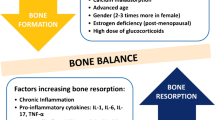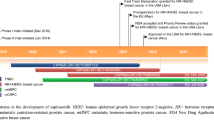Abstract
Multiple myeloma (MM) is the second most common hematologic malignancy and the most common malignancy to involve bone. More than 85% of patients with MM have bone involvement, which can be devastating. Bisphosphonate therapy is the mainstay of treatment for MM bone disease; it has decreased the frequency of skeletal events in MM and delayed their development. Further, the toxicity of these drugs is low and generally manageable. Whether bisphosphonates have any antitumor effects in MM patients (in contrast to what has been reported in preclinical models) is unclear and requires further study. Although bisphosphonates have been extremely effective for treating MM bone disease, they do not completely inhibit the development of skeletal events, but only decrease them significantly. Other antiresorptive agents now being developed may further enhance the quality of life for MM patients when used in combination with bisphosphonates.
Similar content being viewed by others
References and Recommended Reading
Coleman RE: Skeletal complications of malignancy. Cancer 1997, 80: 1588–1594.
Melton LJ 3rd, Kyle RA, Achenbach SJ, et al.: Fracture risk with multiple myeloma: a population-based study. J Bone Miner Res 2005, 20: 487–493.
Diamond T, Levy S, Day P, et al.: Biochemical, histomorphometric and densitometric changes in patients with multiple myeloma: effects of glucocorticoid therapy and disease activity. Br J Haematol 1997, 97: 641–648.
Berenson JR, Lichtenstein A, Porter L, et al.: Long-term pamidronate treatment of advanced multiple myeloma patients reduces skeletal events. Myeloma Aredia Study Group. J Clin Oncol 1998, 16: 593–602.
Yasuda H, Shima N, Nakagawa N, et al.: Osteoclast differentiation factor is a ligand for osteoprotegerin/osteoclastogenesis-inhibitory factor and is identical to TRANCE/RANKL. Proc Natl Acad Sci U S A 1998, 95: 3597–3602.
Hofbauer LC, Heufelder AE: Osteoprotegerin and its cognate ligand: a new paradigm of osteoclastogenesis. Eur J Endocrinol 1998, 139: 152–154.
Pearse RN, Sordillo EM, Yaccoby S, et al.: Multiple myeloma disrupts the TRANCE/osteoprotegerin cytokine axis to trigger bone destruction and promote tumor progression. Proc Natl Acad Sci U S A 2001, 98: 11581–11586.
Sezer O, Heider U, Zavrski I, et al.: RANK ligand and osteoprotegerin in myeloma bone disease. Blood 2003, 101: 2094–2098.
Lacey DL, Timms E, Tan HL, et al.: Osteoprotegerin ligand is a cytokine that regulates osteoclast differentiation and activation. Cell 1998, 93: 165–176.
Terpos E, Szydlo R, Apperley JF, et al.: Soluble receptor activator of nuclear factor kappaB ligand-osteoprotegerin ratio predicts survival in multiple myeloma: proposal for a novel prognostic index. Blood 2003, 102: 1064–1069.
Han JH, Choi SJ, Kurihara N, et al.: Macrophage inflammatory protein-1alpha is an osteoclastogenic factor in myeloma that is independent of receptor activator of nuclear factor kappaB ligand. Blood 2001, 97: 3349–3353.
Alsina M, Boyce B, Devlin RD, et al.: Development of an in vivo model of human multiple myeloma bone disease. Blood 1996, 87: 1495–1501.
Choi SJ, Oba Y, Gazitt Y, et al.: Antisense inhibition of macrophage inflammatory protein 1-alpha blocks bone destruction in a model of myeloma bone disease. J Clin Invest 2001, 108: 1833–1841.
Lee JW, Chung HY, Ehrlich LA, et al.: IL-3 expression by myeloma cells increases both osteoclast formation and growth of myeloma cells. Blood 2004, 103: 2308–2315.
Roodman GD, Kurihara N, Ohsaki Y, et al.: Interleukin 6. A potential autocrine/paracrine factor in Paget’s disease of bone. J Clin Invest 1992, 89: 46–52.
Hjorth-Hansen H, Seifert MF, Borset M, et al.: Marked osteoblastopenia and reduced bone formation in a model of multiple myeloma bone disease in severe combined immunodeficiency mice. J Bone Miner Res 1999, 14: 256–263.
Tian E, Zhan F, Walker R, et al.: The role of the Wnt-signaling antagonist DKK1 in the development of osteolytic lesions in multiple myeloma. N Engl J Med 2003, 349: 2483–2494.
Westendorf JJ, Kahler RA, Schroeder TM: Wnt signaling in osteoblasts and bone diseases. Gene 2004, 341: 19–39.
Giuliani N, Morandi F, Tagliaferri S, et al.: Production of Wnt inhibitors by myeloma cells: potential effects on canonical Wnt pathway in the bone microenvironment. Cancer Res 2007, 67: 7665–7674.
Ehrlich LA, Chung HY, Ghobrial I, et al.: IL-3 is a potential inhibitor of osteoblast differentiation in multiple myeloma. Blood 2005, 106: 1407–1414.
Giuliani N, Colla S, Morandi F, et al.: Myeloma cells block RUNX2/CBFA1 activity in human bone marrow osteoblast progenitors and inhibit osteoblast formation and differentiation. Blood 2005, 106: 2472–2483.
Lee SK, Kalinowski JF, Jacquin C, et al.: Interleukin-7 influences osteoclast function in vivo but is not a critical factor in ovariectomy-induced bone loss. J Bone Miner Res 2006, 21: 695–702.
Toraldo G, Roggia C, Qian WP, et al.: IL-7 induces bone loss in vivo by induction of receptor activator of nuclear factor kappa B ligand and tumor necrosis factor alpha from T cells. Proc Natl Acad Sci U S A 2003, 100: 125–130.
Abe M, Hiura K, Wilde J, et al.: Osteoclasts enhance myeloma cell growth and survival via cell-cell contact: a vicious cycle between bone destruction and myeloma expansion. Blood 2004, 104: 2484–2491.
Yaccoby S, Pearse RN, Johnson CL, et al.: Myeloma interacts with the bone marrow microenvironment to induce osteoclastogenesis and is dependent on osteoclast activity. Br J Haematol 2002, 116: 278–290.
Croucher PI, Shipman CM, Van Camp B, Vanderkerken K: Bisphosphonates and osteoprotegerin as inhibitors of myeloma bone disease. Cancer 2003, 97: 818–824.
Berenson JR, Lichtenstein A, Porter L, et al.: Efficacy of pamidronate in reducing skeletal events in patients with advanced multiple myeloma. Myeloma Aredia Study Group. N Engl J Med 1996, 334: 488–493.
McCloskey EV: Clodronate in the management of breast cancer and multiple myeloma. Ortop Traumatol Rehabil 2003, 5: 227–233.
Heidenreich A, Ohlmann CH: Ibandronate: its pharmacology and clinical efficacy in the management of tumor-induced hypercalcemia and metastatic bone disease. Expert Rev Anticancer Ther 2004, 4: 991–1005.
Russell RG, Xia Z, Dunford JE, et al.: Bisphosphonates: an update on mechanisms of action and how these relate to clinical efficacy. Ann N Y Acad Sci 2007, 1117: 209–257.
Galluzzo S, Santini D, Vincenzi B, et al.: Immunomodulating role of bisphosphonates on human gamma delta T cells: an intriguing and promising aspect of their antitumour activity. Expert Opin Ther Targets 2007, 11: 941–954.
Shipman CM, Croucher PI, Russell RG, et al.: The bisphosphonate incadronate (YM175) causes apoptosis of human myeloma cells in vitro by inhibiting the mevalonate pathway. Cancer Res 1998, 58: 5294–5297.
Gordon S, Helfrich MH, Sati HI, et al.: Pamidronate causes apoptosis of plasma cells in vivo in patients with multiple myeloma. Br J Haematol 2002, 119: 475–483.
Arum SM: New developments surrounding the safety of bisphosphonates. Curr Opin Endocrinol Diabetes Obes 2008, 15: 508–513.
Stewart GO, Stuckey BG, Ward LC, et al.: Iritis following intravenous pamidronate. Aust N Z J Med 1996, 26: 414–415.
Coleman RE: Risks and benefits of bisphosphonates. Br J Cancer 2008, 98: 1736–1740.
Badros A, Weikel D, Salama A, et al.: Osteonecrosis of the jaw in multiple myeloma patients: clinical features and risk factors. J Clin Oncol 2006, 24: 945–952.
Badros A, Evangelos T, Goloubeva O, et al.: Long-term follow-up of multiple myeloma (MM) patients (pts) with osteonecrosis of the jaw (ONJ) [poster]. Blood (ASH Annual Meeting Abstracts) 2007, 110: Abstract 3519.
Kyle RA, Yee GC, Somerfield MR, et al.: American Society of Clinical Oncology 2007 clinical practice guideline update on the role of bisphosphonates in multiple myeloma. J Clin Oncol 2007, 25: 2464–2472.
Lacy MQ, Dispenzieri A, Gertz MA, et al.: Mayo Clinic consensus statement for the use of bisphosphonates in multiple myeloma. Mayo Clin Proc 2006, 81: 1047–1053.
Khosla S, Burr D, Cauley J, et al.: Bisphosphonate-associated osteonecrosis of the jaw: report of a task force of the American Society for Bone and Mineral Research. J Bone Miner Res 2007, 22: 1479–1491.
Vij R, Horvath N, Spencer A, et al.: An open-label, phase 2 trial of denosumab in the treatment of relapsed (R) or plateau-phase (PP) multiple myeloma (MM) [poster]. Blood (ASH Annual Meeting Abstracts) 2007, 110: Abstract 3604.
Mukherjee S, Raje N, Schoonmaker JA, et al.: Pharmacologic targeting of a stem/progenitor population in vivo is associated with enhanced bone regeneration in mice. J Clin Invest 2008, 118: 491–504.
Oyajobi BO, Garrett IR, Gupta A, et al.: Stimulation of new bone formation by the proteasome inhibitor, bortezomib: implications for myeloma bone disease. Br J Haematol 2007, 139: 434–438.
Giuliani N, Morandi F, Tagliaferri S, et al.: The proteasome inhibitor bortezomib affects osteoblast differentiation in vitro and in vivo in multiple myeloma patients. Blood 2007, 110: 334–338.
Terpos E, Heath DJ, Rahemtulla A, et al.: Bortezomib reduces serum dickkopf-1 and receptor activator of nuclear factor-kappaB ligand concentrations and normalises indices of bone remodelling in patients with relapsed multiple myeloma. Br J Haematol 2006, 135: 688–692.
Anderson G, Gries M, Kurihara N, et al.: Thalidomide derivative CC-4047 inhibits osteoclast formation by downregulation of PU.1. Blood 2006, 107: 3098–3105.
Breitkreutz I, Raab MS, Vallet S, et al.: Lenalidomide inhibits osteoclastogenesis, survival factors and boneremodeling markers in multiple myeloma. Leukemia 2008, 22: 1925–1932.
Heath DJ, Chantry AD, Buckle CH, et al.: Inhibiting dickkopf-1 (Dkk1) removes suppression of bone formation and prevents the development of osteolytic bone disease in multiple myeloma. J Bone Miner Res 2008 Nov 18 (Epub ahead of print).
Yaccoby S, Ling W, Zhan F, et al.: Antibody-based inhibition of DKK1 suppresses tumor-induced bone resorption and multiple myeloma growth in vivo. Blood 2007, 109: 2106–2111.
Author information
Authors and Affiliations
Corresponding author
Rights and permissions
About this article
Cite this article
Levy, J., Roodman, G.D. The role of bisphosphonates in multiple myeloma. Curr Hematol Malig Rep 4, 108–112 (2009). https://doi.org/10.1007/s11899-009-0015-4
Published:
Issue Date:
DOI: https://doi.org/10.1007/s11899-009-0015-4




